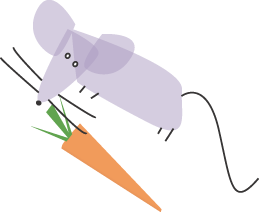Eating less and living longer:
Can’t we find an easier way?
Cutting back dramatically on calories leads to a longer life, at least for species ranging from yeast to rats. But whether not eating the pudding gives the same advantage to humans has yet to be proven.
Tantalizing evidence does exist, however, that cutting calories by 20 percent helps monkeys, who are close relatives, to live longer, healthier lives. And, in one nonscientific program, adults are reducing their caloric intake by as much as 30 percent in the hope of living healthfully (if not too happily) for 100 years or more.

Brian Delaney, who, at age 34, tried going hungry to extend his life, described what it’s like. “I got used to being hungry all the time,” he said, but could not stand the physical result. “I don’t really want to look this skinny,” he complained. “I’m into this whole life extension thing, living to be 120, or 130, or 150, but the idea of living like this for another 80 or 90 years is unappealing.”
But what if scientists can figure out just what combination of genes and proteins extends the lives of so many other living things that don’t fully give in to their hunger. In that case, it might be possible to come up with drugs that would let us have our cake and eat it, too.
David Sinclair and his colleagues at the Harvard Medical School have cooked up some delicious clues to how this might happen. They found an enzyme that makes yeast cells live longer simply because they think they are starving. The enzyme catalyzes a marked increase in the activity of a protein known as Sir2, which in turn promotes yeast survival by reducing events associated with cell death.
With the help of the enzyme, called Pnc1, yeast cells live 70 percent longer. If humans lived that much longer, their average life span would increase from 80 to 136 years. Humans aren’t yeast, or worms, flies, or rats, but they do have a version of Sir2 called SIRT1.
To the inevitable question, Sinclair answers: “It’s pure speculation at this point, but indications are that the same pathway [that was found in the yeast] might be present in humans. There is good evidence that it exists in worms, flies, and other organisms whose lives can be extended by caloric restriction.”
“If we can understand the molecular basis of what’s going on in lower animals,” Sinclair continues, “we might have a chance to understand how it might work in humans, too. What we want to do is find small molecules that would adjust protein pathways in a way that would increase life span.” By small molecules he means the active ingredients in drugs that would help us live longer without almost starving ourselves.
The skinny on not eating
It will be a long time (if ever) before Delaney and the rest of us are able to add years to our lives by taking a pill. In the meantime, restricting calories is the best way to live longer and stay healthy, according to evidence that’s been accumulating for the past decade. Rats and mice whose calories were drastically restricted not only lived 50 percent longer (roughly 120 in human years) but suffered less cancer and other age-related diseases.
Two Harvard studies published in 1997 concluded that being 15 to 20 percent underweight decreased the risk of death from all causes. Other studies have concluded that eating significantly less food lowers blood pressure, increases so-called “good” cholesterol, and cuts the risk of dying from cancer, heart disease, and stroke.
If the work of Sinclair and others can lead to a pill that has all or even some of these benefits, it’s hard to find words that can describe how great that would be.
The researchers describe their work in detail in today’s (May 8) issue of the scientific journal Nature. In the same issue, Richard Turner, a senior editor of Nature, notes that “life span is likely to be controlled by evolutionary ancient mechanisms [of the type found in yeast]. So understanding Sir2 regulation in [higher] organisms, and identifying the genes that are controlled by Sir2 and its relatives, should prove generally rewarding.”




